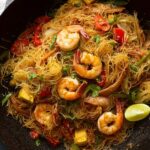Char Kway Teow is a classic Malaysian street food dish, famous for its bold flavors and satisfying combination of shrimp, Chinese sausage, and rice noodles. Stir-fried to perfection with savory soy and oyster sauces, this dish is a perfect balance of salty, sweet, and umami, making it a favorite for noodle lovers around the world. Quick to prepare and full of taste, Char Kway Teow is the ultimate weeknight dinner, bringing the excitement of Asian cuisine to your kitchen in just 20 minutes!
Whether you’re cooking for yourself or entertaining guests, this dish will never disappoint. The crispy texture of the Chinese sausage, tender shrimp, and crunchy bean sprouts, all brought together by the rich soy-based sauce, creates a meal that’s both comforting and exhilarating. Get ready to enjoy a true taste of Southeast Asia from the comfort of your home!
Full Recipe:
-
200g fresh flat rice noodles
-
150g shrimp, peeled and deveined
-
100g Chinese sausage, sliced thinly
-
2 eggs
-
2 tablespoons vegetable oil
-
3 cloves garlic, minced
-
1/4 cup bean sprouts
-
2 spring onions, chopped
-
1 tablespoon dark soy sauce
-
1 tablespoon light soy sauce
-
1 teaspoon oyster sauce
-
1/2 teaspoon sugar
-
1/2 teaspoon white pepper
-
1 tablespoon chili paste (optional)
-
1/4 cup fresh coriander, chopped
Directions:
-
Heat 1 tablespoon of oil in a wok or large skillet over medium-high heat.
-
Add garlic and sauté for 1-2 minutes, or until fragrant.
-
Add Chinese sausage slices and cook until slightly crisp, about 2-3 minutes.
-
Add shrimp and cook until pink, around 3 minutes.
-
Push the seafood and sausage mixture to one side of the wok.
-
Crack the eggs into the empty side and scramble until just set, about 2 minutes.
-
Add the cooked rice noodles, dark soy sauce, light soy sauce, oyster sauce, sugar, and white pepper. Stir to combine and cook for 3-4 minutes, ensuring the noodles are well-coated with the sauce.
-
Add bean sprouts, spring onions, and chili paste (optional) and stir-fry for another 1-2 minutes.
-
Remove from heat, garnish with fresh coriander, and serve immediately.
Prep Time: 10 minutes | Cooking Time: 10 minutes | Total Time: 20 minutes
Kcal: 460 kcal | Servings: 2 servings
Introduction to Char Kway Teow
Char Kway Teow is a beloved Malaysian dish that has become a culinary icon, especially known for its bold, vibrant flavors and delightful textures. This stir-fried noodle dish hails from the streets of Malaysia and features a perfect blend of ingredients like rice noodles, shrimp, Chinese sausage, fish cakes, eggs, and bean sprouts, all cooked together in a flavorful sauce. The hallmark of Char Kway Teow is the signature smoky aroma that comes from the intense heat of the wok, a sensation referred to as “wok hei” (breath of the wok).
While Char Kway Teow might seem simple on the surface, preparing it correctly is an art that has been perfected by street hawkers over the years. At its core, this dish is about balancing texture and flavor while achieving a delicate smokiness. For home cooks, especially those without the high-powered stoves typically found in Asian restaurants, it’s important to embrace the challenge of recreating this masterpiece in a slightly modified but still delicious way.
The Key Ingredients for Authentic Char Kway Teow
To make an authentic Char Kway Teow, you need several key ingredients, some of which may require a special trip to an Asian grocery store. Fresh, wide rice noodles are essential, as they provide the signature soft, chewy texture that makes this dish unique. In addition, Chinese sausage (also known as Lup Chong) plays a pivotal role in Char Kway Teow. This sausage adds a sweet and savory depth to the dish, making it indispensable.
Other essential ingredients include fried fish cakes or pieces, which offer a delightful bouncy texture, and garlic chives, which give the dish a subtle garlicky flavor. While garlic chives can be difficult to find, you can substitute them with regular chives or finely sliced green onions. The sauce, which is a mix of dark soy sauce, light soy sauce, oyster sauce, and kecap manis (a sweet soy sauce), ties everything together and imparts the signature umami flavor to the noodles.
Techniques for Cooking Char Kway Teow
The technique for cooking Char Kway Teow is crucial to achieving the best results. The dish is traditionally cooked in a wok, where high heat is essential for achieving that signature wok hei—the smoky, charred flavor that defines the dish. However, home cooks often lack the powerful stoves found in Asian restaurants, which makes it challenging to replicate the exact street food experience. Even with these limitations, it’s still possible to get close to the authentic taste by following a few key steps.
When cooking Char Kway Teow, it’s important to minimize noodle breakage. Fresh rice noodles are delicate, and they can easily tear apart during cooking. To prevent this, it’s recommended to warm the noodles before separating them, either by microwaving them or running them under warm water. Additionally, when cooking, try to handle the noodles gently and toss them rather than stirring vigorously to prevent them from breaking.
The method of cooking is also important—whether you choose the “base recipe” for experienced cooks or the “easier method” for beginners. The former involves cooking everything in the wok at the same time, while the latter calls for cooking each ingredient separately and combining them at the end. The choice of method will depend on your experience level and the equipment you have available.
The Art of Achieving Wok Hei at Home
One of the defining characteristics of Char Kway Teow is the charred, smoky flavor that comes from cooking in a very hot wok. Known as wok hei, this flavor is created when the ingredients come into contact with the superheated metal surface of the wok, causing the sugars and proteins to caramelize and form that distinctive smoky aroma. Unfortunately, home cooks will never fully replicate the intense heat of commercial woks, but there are ways to come close.
The key to achieving wok hei at home is to use a heavy-based wok or skillet and cook on the highest heat possible. While the charring may not be as intense as in restaurants, you can still get some caramelization on the noodles, Chinese sausage, and fish cakes. This adds a layer of flavor and a slight crispiness to the dish, which mimics the authentic experience.
Substituting Ingredients for Char Kway Teow
While there are several signature ingredients that make Char Kway Teow truly authentic, you can still enjoy a delicious version of this dish by substituting some items if they’re not readily available. For instance, Chinese sausage (Lup Chong) can be substituted with bacon or Char Siu (Chinese BBQ Pork), although the flavors will differ slightly. If you can’t find fried fish cakes, you can use other Asian fish balls, which are available in many supermarkets and Asian grocery stores.
If you’re unable to locate garlic chives, you can use regular chives or green onions. Even the rice noodles can be substituted with dried noodles if fresh noodles are unavailable, though they may not hold up as well to the wok tossing. Keep in mind that these substitutions may alter the flavor profile of the dish, but they will still create a tasty and satisfying meal.
The Importance of Sauce in Char Kway Teow
The sauce is a crucial component of Char Kway Teow. It’s a blend of dark soy sauce, light soy sauce, oyster sauce, and kecap manis (sweet soy sauce), which combines to create a rich, umami-packed base for the dish. Dark soy sauce provides color and a deep flavor, while light soy sauce adds saltiness without overpowering the dish. Oyster sauce contributes a savory depth, and kecap manis brings a touch of sweetness to balance out the other flavors.
Getting the sauce balance right is important, as too much dark soy sauce can make the noodles overly salty and heavy. The sauce should coat the noodles evenly and caramelize slightly, adding flavor to each strand of noodle. When cooking, it’s essential to pause between tossing the noodles to allow the sauce to properly absorb into the noodles and caramelize on the edges.
Serving Suggestions and Pairings
Char Kway Teow is a filling dish on its own, but you can pair it with a variety of sides or accompaniments to create a more well-rounded meal. A simple side of stir-fried vegetables or a refreshing Asian-style cucumber salad can complement the rich, savory noodles. If you want to add a protein boost, you can serve Char Kway Teow alongside grilled chicken, shrimp, or tofu.
This dish also pairs well with a cold beverage, such as a refreshing iced tea or a light lager. The coolness of the drink contrasts nicely with the warmth of the noodles, making it a satisfying and balanced meal.
Conclusion: Bringing the Streets of Malaysia to Your Home
Char Kway Teow is more than just a noodle dish—it’s a taste of Malaysian street food culture. While it may seem intimidating at first, with a few key tips and techniques, you can recreate this dish at home and enjoy its bold flavors, contrasting textures, and smoky aroma. The dish is all about balance—the richness of the sausage, the tenderness of the shrimp, the crunch of the bean sprouts, and the soft noodles come together in perfect harmony.
Whether you opt for the traditional cooking method or the easier approach, Char Kway Teow offers a unique and delicious way to explore the flavors of Southeast Asia. Don’t be afraid to experiment with substitutions or add-ins to make the dish your own. With a little practice, you can master the art of stir-frying and bring a true taste of Malaysia into your kitchen.
Final Thoughts
Char Kway Teow is a dish that requires patience, precision, and a passion for cooking. While the results may not be identical to the ones served on the bustling streets of Malaysia, the essence of the dish is there in every bite. Whether you’re cooking for a special occasion or simply looking for a flavorful weeknight meal, Char Kway Teow is sure to impress. So, gather your ingredients, fire up your wok, and get ready to enjoy one of the most iconic dishes from Southeast Asia!





